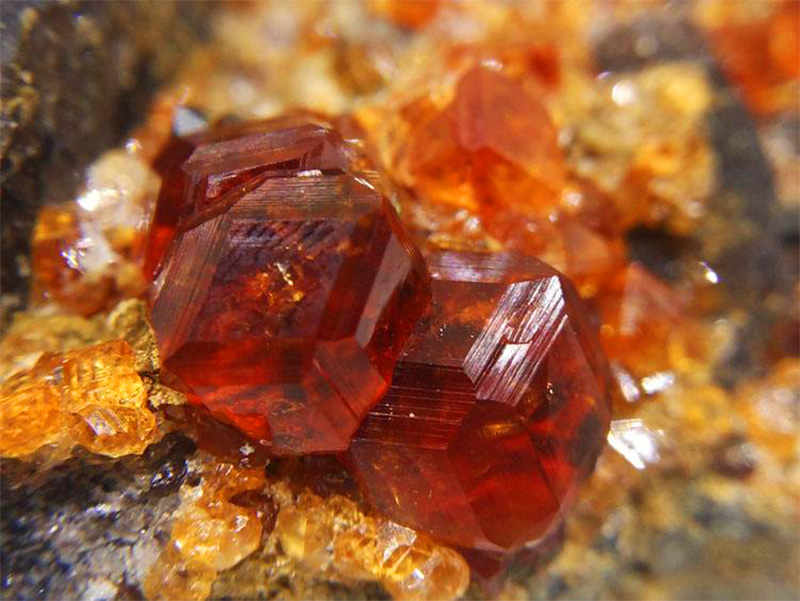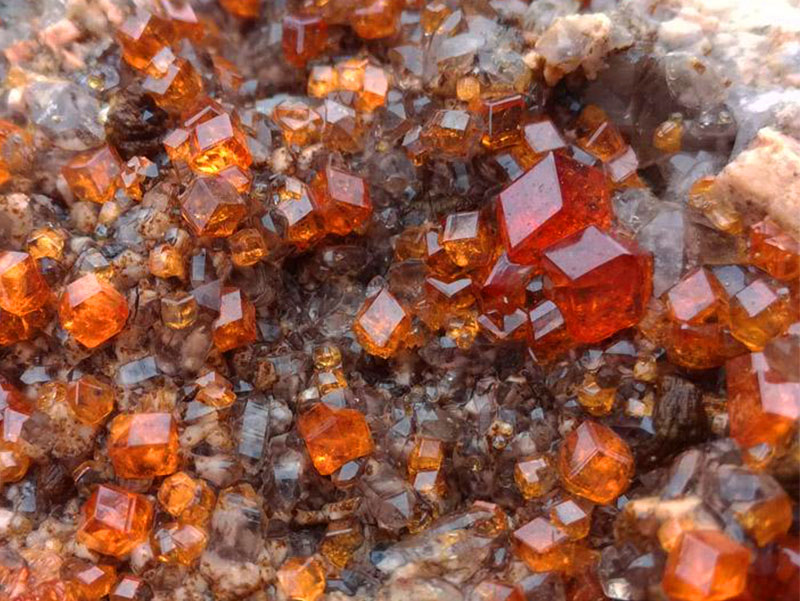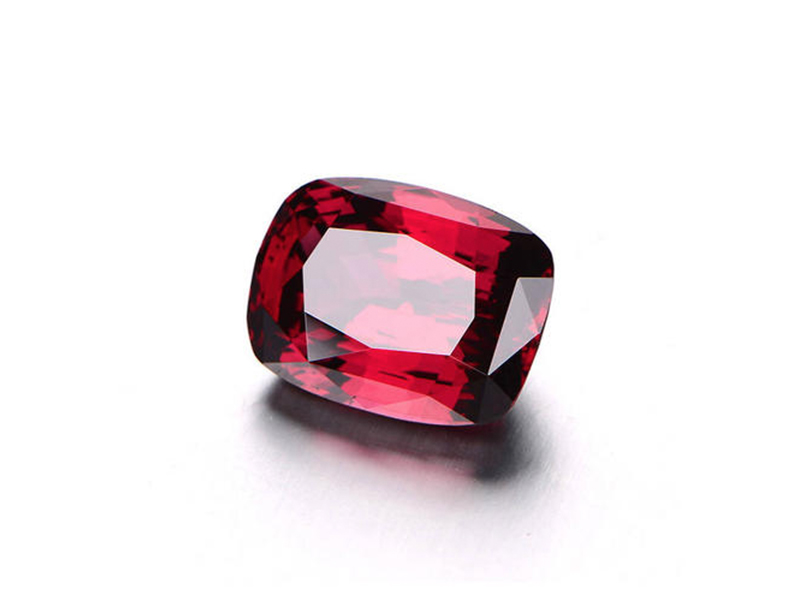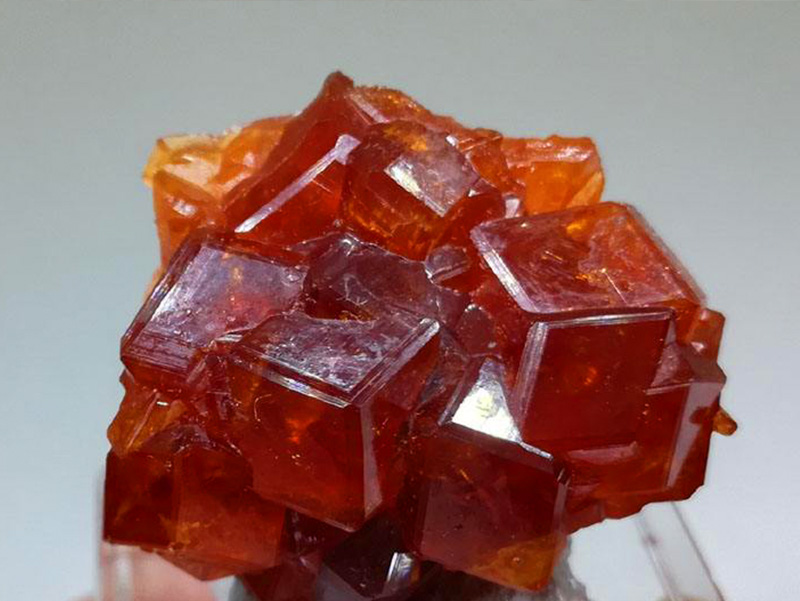JANUARY BIRTHSTONE-GARNET

Basic nature
Garnet, known in ancient China as the purple crow or the sylvestris, is a group of minerals that have been used as gems and abrasives in the Bronze Age. The common garnet is red, the garnet English "Garnet" comes from the Latin "granatus" ("grain", ie grain), probably from "Punica granatum" ("pomegranate", ie pomegranate), it is a kind Red-stained plants are similar in shape, size and color to some garnet crystals.
Common garnets are identified as six types according to their chemical composition, namely Pyrope, Almandine, Spessartite, Andradite, Calcium and Aluminum. Garnet (Grossular, tsavorite and hessonite) and calcium garnet (Uvarovite). Garnet forms two solid solution series: (1) red garnet-iron-aluminum garnet-manganese garnet and (2) calcium chrome garnet-calcium garnet-calcium garnet. There is no hierarchical distinction between garnets in the world. The so-called few A are distinguished according to personal views. The same garnet can tell different A numbers in different hands.
Main ingredient
The chemical composition of garnet is relatively complex, and different elements form different combinations, thus forming a series of garnets of the same type. Its general formula is A3B2(SiO4)3, wherein A represents a divalent element (calcium, magnesium, iron, manganese, etc.), and B is a trivalent element (aluminum, iron, chromium, and titanium, vanadium, zirconium, etc.). Commonly known as magnesium aluminum garnet, which contains chromium and iron and is red, purple and maroon; etc.; followed by iron-aluminum garnet, which is purple-red, crystals of inclusion development, can be polished out of the starlight; The garnet is a pale rose-purple red, which is one of the important varieties of garnet gemstones; the calcium aluminum garnet contains trace amounts of vanadium and chromium ions, so there is a green variety called top grade.
Since the trivalent cations have similar radii, they are prone to substitution with each other. Divalent cations are different. Since Ca has a larger radius than Mg, Fe, and Mn, it is difficult to replace it with a similar image. Therefore, garnets are usually divided into two series:
(1) Aluminum series: Mg3Al2(SiO4)3-Fe3Al2(SiO4)3-Mn3Al2(SiO4)3
It is a series of isomorphous cations such as Mg, Fe, Mn with a small radius and a trivalent cation with Al as the main trivalent cation. The common varieties are magnesium aluminum garnet, iron aluminum garnet and manganese aluminum garnet.
(2) Calcium series: Ca3Al2(SiO4)3-Ca3Fe2(SiO4)3-Ca3Cr2(SiO4)3
It is a series of isomorphous cations with a large radius of divalent cation Ca. Commonly, there are calcium aluminum garnet, calcium iron garnet, and calcium chrome garnet. In addition, some of the garnet lattices are also attached with OH ions to form aqueous sub-species, such as water calcium aluminum garnet. Due to the wide variety of isomorphisms, the chemical composition of garnets is usually very complex. The composition of natural garnets is usually a metamorphic transition state, and there are few garnets with end components.
Crystal habit
Crystal system: equiaxed crystal system.
Crystallization characteristics: The garnet family belongs to equiaxed crystal gemstones. It is an island silicate in the crystal structure. The common crystal forms are rhombohedral dodecahedron, tetragonal octahedron, hexagonal octahedron and polymorph. Pattern. The aggregate is granular or massive.
Optical properties
Refractive index: 1.74-1.90
Gloss: glass luster
Transparency: transparent to slightly transparent
Color: varies from breed to breed
Magnesium aluminum garnet: red, purple, yellow red
Aluminium garnet: brown, dark red, purple
Manganese garnet: yellow orange, orange red
Calcium aluminum garnet: brownish yellow, yellow, yellowish green, green
Calcium iron garnet: yellow green, emerald green, black
Calcium garnet: green

There are also orange and maroon calcium aluminum garnet (guinea garnet) and green, light pink calcium aluminum garnet variant (water calcium aluminum garnet), green water calcium aluminum garnet similar to jade; and honey Wax yellow, yellow brown manganese aluminum garnet, calcium iron garnet is the best for emerald green, which is the reason for the trace chromium. The green calcium iron garnet is also known as the "garnet", the crystal is generally not large, and the high quality garnet larger than 4 carats is rare. Calcium iron garnet also has yellow--green-yellow yellow garnet and black black garnet; calcium-chromite garnet is bright emerald green, which is also related to chromium ion content, but its particle size is too small to be used as a gemstone jewelry. Garnet is an equiaxed crystal system, often a monogonal or polycrystalline crystal of a rhombohedral dodecahedron and a tetragonal octahedron.
Garnet is available in a variety of colors including red, orange, yellow, green, blue, purple, brown, black, pink and transparent. One of the rarest blue garnets was first discovered in Bekily, Madagascar, in the late 1990s. In addition, it is also found in parts of the United States, Russia and Turkey. Because of the high vanadium content (about 1 wt.%, V2O3), its color changes from blue-green to purple under incandescent. Some other types of garnets have the property of color change. In daylight, their color categories are green, beige, brown, gray, and blue; but in white hot light, they appear reddish, purple or pink. Because of their color-changing properties, such garnets are often mistaken for Chrysoberyl. The light transmission properties of various garnets range from transparent samples with gemstones to opaque abrasives for industrial use. The luster of minerals can be classified into glass and resin.
Mechanical properties
Hardness: Because the chemical composition of different kinds of garnets varies greatly, some kinds of atomic chemical bonds are stronger. Therefore, these mineral groups exhibit hardness ranging from about 6.5 to 7.5 Mohs hardness. Harder types such as iron-aluminum garnet are often used as abrasives.
Cleavage: Garnets do not have Cleavage, so when they rupture under pressure, they produce distinct irregularities.
Density (specific gravity): 3.5-4.3 g/cm3.
Geological condition
Place of origin
Magnesium-aluminum garnet is mainly produced in ultrabasic rocks and its residual slope sand deposits, and large-grain gem-grade magnesia-alumina is rare. The former Soviet Union, Norway, the Czech Republic, and China's Jiangsu have output; the ferro-lithite is mainly produced in the United States and Tanzania; the garnet is formed in metamorphic rocks and sandstones such as mica schist and hornblende. The production areas are Sri Lanka, Brazil, Madagascar, India and other countries; calcium garnet is a product of skarn, but also found in the alteration zone of serpentinite and gabbro, such as Kenya, Bakis but the former Soviet Union And China produces green calcium
aluminum garnet. The garnet is produced in Sri Lanka; the garnet is produced in pegmatite, and some metamorphic rocks are also present. Gem-grade manganese-alumina is produced in Myanmar, Sri Lanka, Brazil, etc. Calcium garnet is schist and metamorphic ash. The product of the rock belt is brown and green. The garnet and the yellow garnet are produced in the serpentinite. The black garnet is produced in the alkali-rich igneous rock and is produced in the former Soviet Union and the Congo. Calcium garnet is a hydrothermal solution. Products that interact with calcium-containing ultrabasic rocks have been found in the former Soviet Union and the United States.
Most gem-quality garnets are found in alluvial sands.
Rock temperature history
Garnet group is understood by using geothermal mobarometry
A key mineral of many igneous and metamorphic rocks. The diffusion rate of elements in garnet is slower than other minerals, and garnet is relatively resistant to metasomatism. Therefore, individual garnets that retain their internal composite zone will be used to understand the history of temperature changes in the rock. Some garnets without composite belts are understood to be singular due to diffusion, and the singularity due to the above effects can also be used to predict the history of changes in rock temperature.
Formation condition

Garnet also has its function in analyzing the deterioration of rocks. For example, eclogite can be defined as a rock with basalt composition, but mainly composed of garnet and omphacite. Garnets containing more red garnets can only be produced in relatively high-pressure metamorphic rocks, such as rocks in the bottom of the earth's crust and in the mantle. The peridotite may contain Plagioclase, or a spinel rich in aluminum, or a garnet rich in red garnet.
When all three minerals are present, an olivine (Peridot) and hui are confirmed. The pressure temperature band of the stone mineral balance. The above three minerals are arranged in their peridotite mineral aggregates with increasing stability under pressure. Therefore, pomegranate peridotite can only be produced deep in the earth's crust. The Xenolith of the pomegranate peridotite is brought up by kimberlite from 100 km or more, and the garnet contained in the captured rock fragments is used as an indicator mineral for kimberlite in diamond prospecting. At 300 to 400 km and deeper, the pyroxene component is dissolved in the garnet by replacing 2Al in the regular octahedron (Y) position of the garnet with (Mg, Fe) and Si, producing an unusually high silicon content. Garnet, and has the solid solution properties of magnesium iron garnet. This high silicon content garnet is confirmed to be included in the diamond.
classification
The color of garnet is affected by ingredients and presents a variety of colors. The red series includes red, pink, purple, and orange; the yellow series includes yellow, orange, yellow, and brown; the green series includes emerald, olive green, and yellowish green. The crystal surface is made of glass luster and yttrium luster. Transparent to translucent. Homogeneous body, no pleochroism, no birefringence. Garnet can be divided into two series, six main varieties: iron aluminum garnet series (magnesium aluminum garnet, iron aluminum garnet, manganese aluminum garnet) and calcium iron garnet series (calcium chrome garnet, calcium aluminum garnet) , calcium iron garnet).
Iron aluminum garnet series
(1) iron aluminum garnet
Iron-aluminum garnet is a modern gems called carbuncle (although almost all red gems would be called this name). Red Crystal English "carbuncle" is derived from Latin, which means "live charcoal" or "burning charcoal". The iron-aluminum garnet English "Almandine" is used in Alabanda in Asia Minor, and in ancient times it was the place where red crystals were cut.
The iron-aluminum garnet has a chemical formula of Fe3Al2(SiO4)3. The deep red transparent stone is often referred to as a precious garnet and as a gemstone. It is also the most common garnet gemstone. Iron-aluminum garnets are produced in metamorphic rocks such as mica and schist, and are also attached to minerals such as staurolite, kyanite, andalusite and others. The nicknames of iron-aluminum garnets are "Oriental Garnet", "Iron Aluminum Garnet Ruby", and "Red Crystal".
(2) Magnesium aluminum garnet
Magnesium aluminum garnet, also known as red garnet (from Greek pyrrpós, which means "fire eye") is a red garnet chemically equivalent to magnesium aluminosilicate, chemical formula Mg3Al2(SiO4)3, magnesium position It can be replaced by calcium and ferrous iron. The color of the red garnet ranges from deep red to black. Transparent red garnet will be used as a gemstone.

The red garnet from Macon County, North Carolina, is a purple-red color called rhodolite, which is derived from Greek in English and means "rose". Its chemical composition is a homogenous mixture of red garnet and iron-aluminum garnet, and its specific gravity is two parts of red garnet and one part of iron-aluminum garnet.
A garnet converted from blue to Madagascar, a mixture of red garnet and manganese aluminum garnet. Its blue color is not as blue as sapphire in the sun, but in the nostalgic gray blue and green blue that can be seen in the spinel.
However, under the light of a white LED, its color is converted into the best blue gems of cornflowers, or tanzanites of the D zone, because the blue garnet has the property of absorbing the yellow component of the emitted light.
Red garnet is an indicator mineral of high pressure rock. Some of the rocks produced in the mantle, such as peridotite and eclogite, contain garnets that usually contain some red garnet species.
(3) Manganese aluminum garnet
Manganese aluminum garnet, the chemical formula is Mn3Al2(SiO4)3. Its English "Spessartine" comes from Spessart in Bavaria. They are usually produced in granite pegmatites and their associated rocks, or in some low-quality metamorphic phyllites. A beautiful orange-yellow manganese-aluminum garnet can be found in Madagascar, the Madagascar garnet. Fuchsia manganese aluminum garnets can be found in rhyolites in Colorado and Maine.
Calcium garnet
Calcium is located at the position of X: calcium iron garnet Ca3Fe2(SiO4)3, calcium aluminum garnet Ca3Al2(SiO4)3, calcium garnet Ca3Cr2(SiO4)3.
(1) Calcium iron garnet
Calcium iron garnet has a chemical formula of Ca3Fe2(SiO4)3, which may be red, yellow, brown, green or black depending on the chemical composition. The confirmed types are yellow or green topazolite, green demantoid and black melanite. Calcium garnet can be found in deep igneous rocks such as syenite, serpentines, schists and crystallized limestone. The garnet was once called "Ula's emerald" because of its origin, and it is also one of the most valuable garnets. Yellow garnet is a golden yellow variant of calcium iron garnet and black garnet is a black variant.
(2) Calcium aluminum garnet
The chemical formula is Ca3Al2(SiO4)3, although the calcium position can be replaced by ferrous iron and the position of aluminum can be replaced by ferric iron. Calcium aluminum garnet English name "Grossular" comes from the botanical name "grossularia" of gooseberry, which is due to the discovery of green garnet composed of the above ingredients in Siberia. Other colors are cinnamon brown (Cinnamon stone variety), red and yellow. Because it has a relatively poor hardness with a similar yellow zircon, its other English name is "hessonite", from Greek, meaning low. Calcium garnet can be found in the contact surface of degraded limestone with vesuvianite, diopside, wollastonite and wernerite. One of the most interesting variants is the pure green calcium aluminum garnet from Kenya and Tanzania called the Schaffnerite. This garnet was discovered in the Tsavo region of Kenya in the 1960s and was also named after it.
(3) Calcium chrome garnet
The chemical formula is Ca3Cr2(SiO4)3, a rare bright green garnet usually found in fine crystals with chromite in peridotite, serpentine, and kimberlite. It is found in the crystals and schist of marble in the Ula Mountains of Russia and Outokumpu, Finland.
Magnesium chrome garnet
The magnesium garnet has a chemical formula of Mg3Cr2(SiO4)3. The chrome garnet of the endmember will never appear in nature. Magnesia garnet is produced only under high pressure and is often found in kimberlite. It is used as an indicator mineral to test for the presence of diamonds.
Rare species
(1) Calcium is located at X:
Calmanite garnet (Goldmanite) Ca3V2 (SiO4)3, zirconium garnet (Kimzeyite) Ca3(Zr,Ti)2[(Si,Al,Fe)O4]3, calcium garnet (Morimotoite) Ca3TiFe(SiO4)3 , titanium garnet (Schorlomite) Ca3 (Ti, Fe) 2 [(Si, Ti) O4] 3 .
(2) Attached with hydroxide-calcium at the position of X:
Hydrologrossular Ca3Al2(SiO4)3-x(OH)4x, Hibschite Ca3Al2(SiO4)3-x(OH)4x, (x between 0.2 and 1.5), Kato stone (Katoite) Ca3Al2(SiO4)3-x(OH)4x (x is greater than 1.5).
(3) Magnesium or manganese is located at the position of X:
Knorringite Mg3Cr2(SiO4)3, Majorite Mg3(Fe,Al,Si)2(SiO4)3, Calmanite Mn3Fe2(SiO4)3.
Synthetic synthesis
Yttrium iron garnet (YIG), the chemical formula is Y3Fe2(FeO4)3, five ferric ions occupy the position of two regular octahedrons and three tetrahedrons, and the trivalent europium ions are arranged by eight oxygen ions. Into an irregular cube. The position of the two iron ions shows a different spin, producing magnetism.钇 is a Ferrimagnetism material with a 550K Curie temperature. If a rare earth metal is substituted for an individual position, special properties such as magnetism will occur. Yttrium iron garnet is used in microwave and optical communication instruments because of its magnetic and magneto-optical properties. Gadolinium gallium garnet, chemical formula Gd3Ga2(GaO4)3, can be used as a magnetic bubble memory after synthesis. Yttrium aluminium garnet (YAG), chemical formula Y3Al2 (AlO4)3, is chemically synthesized and used as a gemstone. When ruthenium (Nd) is applied, yttrium aluminum garnet is used as an active laser medium of a Nd:YAG laser.
Application

Garnet sand is a good abrasive, and it is also a common substitute for silica sand in sandblasting.
After mixing with high pressure water, garnet is used as a cutting steel and other materials in a water jet cutter.
Garnet sand is also used as a medium for water purification.
Garnet filter, also known as “jass” or “natural corundum”, has strong hardness and good acid and alkali resistance. It is an island-like aluminum (calcium) silicate, which is beautiful in color. High-purity magnetically selected gray, red, green, white and other chromosomes, is the newly developed three-dimensional spray wall coating in foreign countries, or the only glass shell plant can do color shell sandblasting and wear-resistant materials, due to its internal chemistry More molecules, good chemical stability and so on. It is made of quartz sand, petroleum coke (or coal char) and wood chips as raw materials through high-temperature smelting in an electric resistance furnace.
Symbolic meaning
In the United States it is the January birthstone, the jewel of the second anniversary of the wedding anniversary, the state mineral of Connecticut, and the gemstone that represents New York.
evaluation standard
(1) Color: The lighter the better, the crystal color of garnet is heavier than other ones, so the color is very difficult! The kind of look at the past with black is the worst color. In addition to the special garnet, we are more common with red garnet. However, the color varies depending on the color of the color. The price is the highest with purple garnet, followed by rose. On the basis of these colors, the lighter the color of the garnet, the higher the price, and the black garnet is the second-class garnet.
(2) Inclusions: The less the better.
(3) Fracture: The less the better, the natural spar will have natural ice cracks in the body. It is a normal performance for garnet. It is difficult to find something that is not at all! The one that doesn't have one is definitely the top grade. It must be the existence of the price of garnet! The garnet with ice crack is normal, but the less the ice crack, the better. In fact, all natural crystals are like this. No absolute, only relative.
(4) Crystal Permeability: The more transparent the crystal, the higher the price. The good garnet bracelet is transparent to the whole crystal under the illumination of a single light source, just like a round and full pomegranate seed. A little garnet or an artificial garnet will not have such a good effect.
(5) Overall texture: The top garnet has a bright surface and a strong luster. The texture of the good garnet is much higher than the price of the same kind of texture.
maintenance
(1) Handle gently to avoid collision and friction.
(2) Avoid high temperature and avoid contact with acid and alkali solution.
(3) Inlaid jewelry must be inspected frequently to avoid jewels falling off.
(4) Try to avoid wearing it when doing housework or labor.
(5) Clean with warm water and a soft brush.
Top quality
Garnet is produced almost everywhere in the world, and Germany is the country with the largest number of garnets.
It is recognized that the most precious garnet is the "Dian Mandu Garnet" from the gold mine of the Pobrov River bed in the Ural Mountains. This garnet rough is generally small and generally does not weigh more than 3 carats.
Because it has an attractive green color, it is called "Ural Emerald", and the top grade is worthless.
The largest piece of garnet rough in history weighed 20 tons and used 100 horses when carrying it. The "rose garnet" from the Ural Mountains was carved into the shackles of Nikola I, the grandson of Catherine II.
The National Museum of Natural History houses the world's best brown-yellow transparent garnet (iron-calcium aluminum garnet), a sculpted Christ head that weighs 61.5 carats and is invaluable.
The China Geological Museum houses a large crystal of orange-red manganese aluminum garnet produced in Xinjiang, weighing 1,397 carats.
Rare gemstones - natural eclipse like garnet:
(1) Size: ∮ 10.5cm
(2) Weight: 1600 g
(3) Color: yellow green
(4) Hardness: 7.5 degrees
(5) Origin: Donghai, Jiangsu, China
(6) Collectors: China Quaternary Glacier Relics Exhibition Hall
This jade pomegranate petroleum grease ~ glass luster, the color is olive green, the surface of the crystal has a natural diamond-shaped concave hole eclipse, found in the East China Sea in April 2011 in China, and was collected by the China Quaternary Glacier Relics Museum.
The high dispersion of garnet and the "horse tail" inclusions are important markers. Viewed under the microscope, there are some asbestos fibers in the garnet, which are curved from the crystalline inclusions in the middle to bend yellow-brown to yellow fibers. These bundles of filaments and divergent linear inclusions look like fireworks.
These fibrous inclusions often appear individually or in groups without a distinct shape or divergent center. This is a sign of distinguishing between true and false garnets. High purity is the only gemstone that does not require manual filling and can not be faked.
